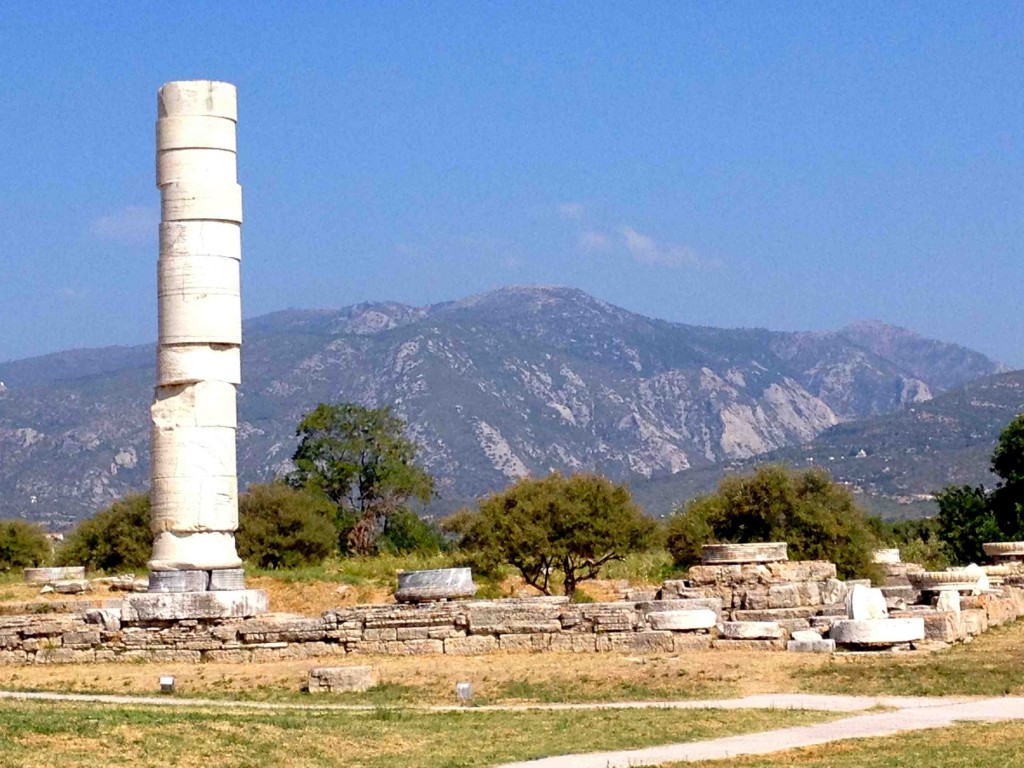I spent some time in Mytilini, a mountain village on the island of Samos, Greece last month, an island located a mile off the Turkish coast. During our visit we explored the south central part of Samos island beginning with the ruins of the temple of Hera. It was built in stages beginning in the 8th century BC and the temple was much larger than the Parthenon but subsequent builders saw it as a good supply of ready cut stones for building new things.
Only one column is still standing and it is half its original size that must have been over 60 feet. You can see the Scared Way that led from the temple to old city of Pythagora. It was paved in the 7th century BC and ran almost 5 km.
Next we walked around the seaside town of Ireo. There were a number of waterfront restaurants and one advertised live music on Monday and Friday.
Next we stopped at the Tower of Sarakinis built in the 16th century AD. It was a left to a monastery on the island by the boatswain of the Ottoman Captian Kilic Ali Pasha who encouraged the re-population of the Samos in 1562. Beside it is a small, unusually shaped church.
We also drove through some remote mountain villages with peaceful shaded town squares. We are trying to do as many secondary paved roads as we can. Below is the town square in Myloi and the town from the hills above it. The green spot in the center is the town square with a very large old tree. This is usual situation in Greek inland villages, a central square with a large shade tree or several trees, and at least one taverna or cafe. The seaside villages, like Ireo above, run the central street and tavernas along the sea and are less likely to have a central square.
Next stop was Paghondas shown below. The second picture below shows the view from our table at Paghondas where we had foamy ice coffee, the Greeks call a frappe. Inside the cafe was a very large black and white photograph taken in New Jersey of a 1925 reunion of Greeks who immigrated to the US from Samos. The owner gave us permission to photograph the pictures. We have met a number of people here with American cousins. Next you see the familiar sight of laundry hanging out to dry. In this case it is across from the town square. Clothes dryers are rare on the island with its wind and sun. We did not take the steep ramp shown below to the parking lot but parked on the upper street.
The road from Paghondas to Spatharaioi went along a ridge offering sweeping views to the sea and Mount Kerkas. You could also see the effects of large wild fires that swept sections of the back country several years ago.
We later had lunch in Mavratezi, an even more remote mountain village known for its ceramics. We had a very traditonal lunch: souvaki (grilled pork on skewers), Greek salad, the best bread we have had on the island (from a bakery in Hora), and Tzatziki for 11 Euros. The weather has consistency cooled to the mid-80s so it is pleasant to do things during the day.
Post Script 1: Below is our view from dinner in Ireo as we sat at a corner table in the restaurant shown in first photo. There is Turkey across the water and the Straits of Mikali separating Greece and Turkey. We had dry and sweet white wine with grilled bread, fried mussels, fried calamari, and grilled shrimp. Then we were served a complementary desert of a sweet cake at the end. The view from our table looking the other way follows the dinner pictures. Next we went to a fish tavern to hear some excellent traditional Greek music. Dancers got going part way through.
Post Script 2: Near the temple of Hera is a stretch of beach where you can drive on the back side of the beach. On several of our first nights on the island we watched the sunset over the mountains of Samos behind us and then saw the moon rise over the mountains in Turkey in front of us. We shared the view with a lone surf fisherman on two nights and had it to ourselves on the other.









